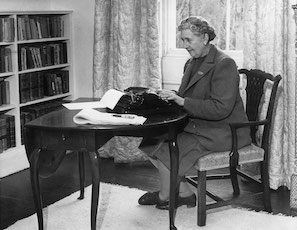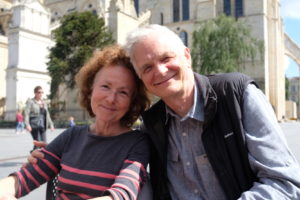Agatha Miller, was named after the vibrant heroine of Dinah Craik’s novel Agatha's Husband.
She was born to a wealthy upper class family on 15th September 1890, the youngest of three children. Her mother, Clara, was 36 years old, and her father, Frederick Miller, a wealthy New Yorker, was 44. Agatha’s sister, Margaret [Madge], was born in 1879, and her brother, Louis Montant (Monty), in 1880. The family lived in a rather grand house, ‘Ashfield’, in Torquay – a resort in Devon on the English south coast.
Madge was sent to Miss Lawrence’s School, Brighton, which later became Roedean. Madge fulfilled the dreams of an upper class Victorian girl, had her debutante season and married James Watt in 1902. She published several short stories, and in 1924 her play, The Claimant, was put on in London’s West End.
Monty went to Harrow School, but left without any examinations. He tried to make a living farming in Kenya and Uganda but was frequently destitute. In 1922 he returned to England with an African servant, Shebani, whose wages were paid by Madge and Agatha. Monty died young from drinking too much alcohol. In some of Agatha Christie’s novels there are irascible ex-colonials with patient, loyal, ‘native’ servants, modelled perhaps on Monty and Shebani.
Agatha was a shy, lonely child who read voraciously, but she had a cat, a Yorkshire terrier called Toby, and a canary called Goldie. She saw her mother only once a day after tea in the drawing room. She learned piano and mandolin from an early age at the encouragement of her father, and he gave her an arithmetic lesson every morning, after breakfast, which she enjoyed. She knew ‘Cook’ and ‘Nursie’ better, however, than she knew her parents.
When Agatha was 5 years old her father’s business investments dwindled, possibly due to fraud. The Millers had to rent out their house and live on the rent for much of the year in France. Their finances were further reduced when Agatha’s father died from pneumonia in 1901. Agatha was 11 yrs old.
Agatha suffered little formal education. At age 13 years she attended Miss Guyer’s Girls’ School in Torquay to learn algebra, grammar and spelling, but for only two days per week. In 1905 she was sent to Paris for ‘finishing’. She considered a career as a concert pianist but had such stage fright when asked to play for a visitor that she decided that she ‘did not have the temperament to play in public’.
In 1910 Agatha Miller, aged 20, had her debutante season in Cairo: it was much cheaper than the Court of St James. She fell in love with the Pyramids and the Sphinx but not with any young gentleman. And then, in 1912, she met the dashing Archie Christie at a dance. He was one of the few people in Britain able to pilot an aeroplane. On the 24th December 1914 Archie and Agatha married, spent the night in the Grand Hotel, Torquay and then on the 26th December Archie returned to the fighting in France. They saw little of each other until the end of the War in 1918. During the War Agatha volunteered as a hospital ‘ward-maid’, cleaning and scrubbing. Her fluent French was useful, and proved seminal in the creation of her most famous detective: she translated for the Belgian refugees in Torquay. Subsequently she worked in the hospital pharmacy and, for the first time in her life, she studied for exams, at the Apothecaries’ Hall – gaining knowledge on poisons.
After the First World War, Archie and Agatha Christie started their married life in a flat in London, with Archie’s batman, Bartlett, looking after them. On August 5th 1919 their daughter, Rosalind – named after the heroine in As You Like It - was born. In 1922 the Christies, without Rosalind, went on a round-the-world tour by ship, an experience that Agatha makes use of in several of her early novels. Agatha was one of the first women in Britain to take up surfing which she came across when the ship visited South Africa.
And then Archie fell in love with Nancy Neele – his golfing partner. 1926 was Agatha Christie’s annus horribilis. Her mother died, she became depressed, and then Archie asked for a divorce. Agatha was in despair. On Friday 3rd Dec 1926 at 11pm she drove off alone without telling anyone where she was going, leaving the seven-year-old Rosalind asleep in the house. Agatha’s car was later found abandoned. Police and volunteers dragged the lakes and searched the area. Ten days later Agatha was recognised at the Hydro Hotel, Harrogate, where she was signed in as ‘Mrs Theresa Neele’. Archie identified her on Tuesday 14th December. He wrote: ‘She has suffered from the most complete loss of memory and I do not think she knows who she is’. Agatha never answered questions about the period of her apparent memory loss. Agatha and Archie Christie divorced in 1928. She went on to write bitter ‘romances’ under the nom de plume Mary Westmacott, two of which, Giant’s Bread (1930) and Unfinished Portrait (1934), are semi-autobiographical.
In 1917, during a solitary two-week holiday, Agatha wrote The Mysterious Affair at Styles. It was rejected by several publishers, but, finally, John Lane at The Bodley Head agreed to publish it, with a contract for four further books. Once she was free from this five-book contract, Christie’s literary agent, Edmund Cork, negotiated a better deal with Godfrey Collins. The first book she wrote for Collins was one of the most successful crime novels ever written, The Murder of Roger Ackroyd, published in her annus horribilis. From then on Collins published all her crime novels and Cork remained her agent and friend for 50 years.
After her break-up with Archie, Agatha was a working ‘single mother’. Then, in 1930, when she was nearly 40 years old, she met the 26-year-old Max Mallowan, a friend of her nephew’s, at an archaeological dig. They married in September 1930, to the chagrin of Agatha’s family who thought that Mallowan was only after her money. Despite all the negative prophesies, they appear to have had a happy marriage until Agatha’s death in 1976.
Agatha Christie never felt entirely secure in her talent. Her mother-in-law had suggested that with her intelligence she would be able to write a good biography of Shakespeare instead of wasting her time on crime fiction! But Max, a distinguished archaeologist, appreciated her brilliance. He was given a knighthood in 1968 and so Agatha could be known as Lady Mallowan. And then, in 1971, at the age of eighty, whilst still writing and publishing crime novels, she herself was knighted (honoured with a damehood) and became Dame Agatha Christie.
About Us
We met at medical school. On our first holiday together we packed a few of Christie's novels. Sally had never read one. We read Peril at End House aloud to each other. We stayed up late and continued reading the next day. We stopped before the dénouement and over dinner discussed the novel, committed ourselves to a solution, and then read the ending, to see whether we were right.
Reading aloud to each other has been a great pleasure. Every so often, when we want sheer fun and a puzzle, one of us will say: ‘Let’s read an Ag.’ Over the last forty years we have read to each other almost all Christie’s crime novels in haphazard order. For this project we decided to read the novels in the order of publication, dividing the 66 novels between us, and this time reading them to ourselves.
Sally
I am a dyslexic retired family doctor. Reading Agatha Christie out loud with Tony has helped my reading fluency. What surprised me was even knowing the solutions, re-reading these Christies many times, they get even better. Her skill at hiding clues, like plums in a pudding, and her humour, as well as her interest in everything from Jazz to Einstein, makes her books so readable and enjoyable.
Tony
My parents read aloud to my sister and me: anything from Doctor Dolittle to David Copperfield, and including Agatha Christie. I remember, around the age of 9 years old, being fascinated by the mysterious woman in the red kimono – the word alone was exotic – in Murder on the Orient Express. I was given The Pale Horse hot off the press in 1961 and from then on I waited excitedly for the next ‘Christie for Christmas’.
We thank Matthias De Cnuydt, who like Poirot is from Belgium, for his design of this website and for his superb technical help.
We will rate each novel with one to five stars and a Poirot Score out of 100.
The score will be given principally for the quality of the plot, the clues, the misdirections and the solution. In other words, the score mainly reflects how good the novel is as a puzzle and whodunnit (in our view). We will also, to a lesser extent, take account of the humour, characters, pace and story, and of the enjoyment the novel has given us. These factors will be given relatively greater weight in those novels that are more adventure story than whodunnit.
We consider the following characteristics as contributing to the score:
- The solution accounts for the facts, and there are no significant facts that contradict the solution or are not adequately explained.
- The solution does not depend on quite extraordinary assumptions or highly unlikely happenings.
- The solution does not depend on an arcane piece of knowledge unless this is given before the dénouement.
- Alternative solutions are not as plausible as the given solution.
- The solution is clued fairly.
- There are several clues for the solution. The best clue structure, in our view, is when two or more clues have to be put together for the clues to work – each clue taken individually is inadequate.
- The solution is not obvious.
In the very best plots, although it is difficult for the reader to solve the puzzle, if the reader does hit on the correct solution s/he can be almost certain of having got it right. We call this the cryptic crossword criterion.
✰ Poirot score: less than 50
One of the poorest Christie novels. Either a mediocre whodunnit or a rather dull adventure story.
✰✰ Poirot score: 50-59
If a whodunnit then the clues are poor or the solution arbitrary. If an adventure story then reasonably entertaining.
✰✰✰ Poirot score: 60-74
A good whodunnit. Entertaining and with several clues. The solution is fair to the reader although other solutions are possible. Or if this is one of Christie’s adventure stories it is a very good read.
✰✰✰✰ Poirot score: 75-84
A consummately executed whodunnit, well clued but with clever misdirections. The solution is better than alternatives although not necessarily the only one possible. A really good read.
✰✰✰✰✰ Poirot score: 85-100
A classic. Either a genre-extending plot, or a clever plot quite superbly clued. The solution not obvious but if you hit on it in a flash of insight you will be almost certain you are right. A first-rate, entertaining, whodunnit.

